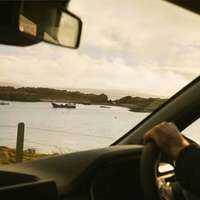
By Rachel Sullivan
April 2024
On Inishbofin, a tiny isle off the west coast of Ireland, travelers find perfect beaches, majestic landscapes, a thriving food scene—and a warm Irish welcome
Off the rugged west coast of Ireland, where tales of shipwrecks and storms run deep in the culture, you find the tiny island of Inishbofin. Like the fictional setting of 2022 film The Banshees of Inisherin, it’s steeped in myth and legend—even its name, which means “Island of the White Cow,” harks back to a time when mainlanders thought it floated on the Atlantic, shrouded in mist.

In summer the ferry runs three return trips a day from Cleggan to “Bofin”

A handcrafted sign welcomes visitors to the island
But passengers arriving today on the 30-minute ferry crossing from Cleggan—when you might see minke whales, or bottlenose dolphins jumping out of the water—are greeted with a striking mix of rich traditions and melting-pot modernity, not least in its food scene. After The Beach pub, one of the first welcoming sights is The Salt Box, a vintage Airstream trailer from which Italian emigrant Sara Attanasi serves fresh grilled crab, pollock, and lobster oozing with garlic butter, caught fresh by her fisherman husband Marcus.
“It’s gorgeous in summer,” she says. “When the ferry arrives, people sit down in the fresh air to enjoy the view and listen to the folk and jazz music we play.”

Local fisherman David Lavelle sells his catch to the island’s food trucks

Fresh crab straight from the sea
And oh, that view: Rugged, undulating landscapes that change color by the second. Warm, welcoming, music-filled pubs that serve pints of stout thicker than half-and-half. Craggy stone walls around green fields where there are more sheep than people. Just 3.5 by 2.5 miles, Inishbofin has a population of less than 200, bolstered by visitors who have heard about its surprisingly good food scene, its white-sand beaches, its clear waters, and its warm welcome. Inishbofin delivers what Oscar Wilde called his country’s “savage beauty” in spades.
Not far from Ireland’s scenic west coast road trip, the Wild Atlantic Way, legend has it that Inishbofin was an enchanted, floating place until two fishermen landed there by mistake when lost in the fog. The fire they lit revealed an old woman driving a white cow; she struck the cow and turned it into the island that exists today.

Free-wheeling on the Wild Atlantic Way
Ireland’s coastal route takes in 1,600 miles of dramatic cliffs, cosy pubs and sacred sites

The ruins of Cromwell’s Barracks date back to the 17th century

The rugged North Beach
But the historical facts are as fascinating as the folklore. These encompass bogs, blowholes and maritime catastrophes, and that Inishbofin was the last place captured by Oliver Cromwell’s English army in 1652. In fact, the first sight you’ll see as the red and white ferry pulls into the island’s charming harbor, past the last crag of land before the Atlantic swirls its way west to Boston, is the imposing silhouette of Cromwell’s Barracks. This star-shaped ruin is well worth the scenic hilltop walk—just be careful not to get cut off by the rising tide.
Like many island communities, what travelers find here is both unique and universal: a pride in the landscapes, traditions and culture that’s tangible, and a welcome that stays with you forever.







There are very few cars, so take a walking tour of the island’s viewing points and beautiful beaches, where treasure troves of periwinkles, cockles and clams are covered in bright bolts of seaweed that look like alien life forms.
Dumhach Beach is particularly wonderful. Bird spotting is a joy here, with corncrakes, terns and guillemots calling eerily across the bay. There’s also a snorkel trail from Fawnmore Beach, where you’ll see the stuff of sea-shanty legend: sea anemones, limpets, barnacles and hermit crabs.
In summer, rent a bike at Kings Bicycle Hire and explore the island’s not-too-hilly roads, or charter a boat from one of the few on-island companies.
While choice is limited in Inishbofin, the food is seasonal, sustainable and surprisingly on-trend. Head to The Salt Box, a family-run Airstream trailer a few strides from the pier that serves freshly caught fish al fresco, or Inishwallah, an Indian-inspired double-decker bus perched high on a hill—both open only in summer.
Year-round the action is, unsurprisingly, at the local pub The Beach (referred to by locals as “Beaches”). A convivial watering hole, you’ll find live music if you’re lucky, a wood-burning stove, a mean Irish coffee, and creamy chowder rich with salmon and lobster. In the pub, chat to one of Inishbofin’s locals (see box, above): Respect for the sea is bred into their bones, and they’ll tell you about shipwrecks and storms, such as the 1927 Cleggan Bay Disaster, when a gale caused the deaths of 45 fishermen.
In summer, you have a few options including Doonmore Hotel and the Dolphin Hotel (which also hosts the village shop, whose produce gives a fascinating insight into island life; plus a great selection of Connemara wool socks and works by local artists). Or you could make things easy on yourself and just stay at the Beaches pub.

Rachel Sullivan is Expedia Group’s Executive Creative Director of Editorial. Before joining Expedia, she had a career in magazine publishing, writing for titles from Condé Nast Traveller to Brides, Red and The Sunday Times.
